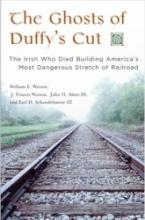The first railroad tracks in the U.S. were laid by hand, reportedly over a three mile stretch in Massachusetts. Horses pulled the first carts to run on that three mile track, in 1827. By 1829, Delaware & Hudson Canal Co. put the Stourbridge Lion to work on their mine tracks, the first steam locomotive in America. The locomotive is retired as a stationary boiler when she turns out to weigh twice as much as she was supposed to, according to her builders, and is too heavy for the tracks. But locomotives and railroads were very clearly going to be a large part of the future of this young and energetic country.
Laying track was brutal work, and didn't pay well. Even slave-owners were reluctant to rent out their slaves to lay track. Like much physical labor, laying railroad track fell to migrant workers and immigrant labor. Mile after mile of the early tracks in America were built almost entirely by Irish immigrant labor. So very difficult and dangerous was the work of laying track that there's a chilling old saying about it: Under every mile of railroad track is a dead Irishman.
57 Irish workers were hired immediately upon their arrival at the docks in Philadelphia in June of 1832 by one Phillip Duffy (himself not too long off the boat from Ireland, and fluent in the language) to cut a line of track through some particularly steep and hilly terrain. Just a few weeks later, they were all dead, dumped ignominiously together into a mass grave and covered with the dirt and rock they themselves had just removed to lay track for the Main Line through a particularly difficult area, dubbed "Duffy's Cut."
For nearly a decade, Dr Frank Watson, his brother William Watson, and a team from Immaculata University have been tirelessly digging for the truth of what actually happened to those 57 young men, almost two hundred years ago. In 2009, they found the first two skulls of the men's remains, and at the same time, began to uncover an early American mystery:
Archaeological researchers excavating Duffy’s Cut, the infamous dig-site where Irish railroad workers were found buried en-mass, have uncovered two more skulls which show evidence of blunt force injuries to the skull.
While the official story in 1832 was apparently that all the workers had fallen victim to Cholera, quarantined, and abandoned to die—physical evidence suggest that several of the men were actually quite coldly and brutally murdered. Dr. Watson intends for the team to positively identify as many of the victims as they can, to contact any remaining descendants or relatives, and perhaps even return the remains to their families for a more proper burial.
Frank and William Watson have co-written a book with two other scholars, revisiting the history of these Irish railroad laborers, about the years of searching for the dead men left in Duffy's Cut, and the truth of what they've discovered buried beneath those miles of railroad track.
